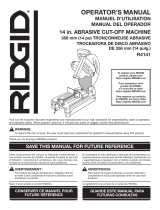
English
5
16. ALWAYS USE RECOMMENDED ACCESSORIES ONLY, WHEN OPERATING THIS TOOL.
Consult this instruction manual for descriptions of recommended accessories. To avoid
personal injuries, use only recommended accessories in conjunction with this tool.
17. NEVER STAND ON TOOL. Prevent serious injury by not tipping the tool and by not
risking unintentional contact with the cut-off wheel.
18. ALWAYS CHECK FOR DAMAGED PARTS BEFORE USING TOOL. Always check the guard
and all other components for damage before using the tool, to assure that they will
function properly. Check all moving parts for proper alignment, freedom from binding
and other conditions that might affect proper operation. Always repair or replace any
damaged guards or other damaged components before using the tool.
19. NEVER LEAVE THE TOOL RUNNING WHILE UNATTENDED; ALWAYS TURN THE
POWER OFF WHEN THE TOOL IS NOT IN USE. Always unplug the power cord when
the tool is not in use. Don’t leave tool until it comes to a complete stop.
20. This tool was not designed to be used for mass-production applications, and should
not be used in mass-production environments.
21. This tool is intended for residential use only.
22. When servicing this tool, use only authorized replacement parts.
23. Apply AC 120 volts only to this tool. Applying the wrong voltage could cause the POWER
TOOL to operate improperly and could cause serious personal injury or damage to the
tool.
Specific Safety Rules for Use of this Power Tool
WARNING: The following specific operating instructions must be observed when
using this POWER TOOL, to avoid injury:
DO’s
ALWAYS OBSERVE THE FOLLOWING RULES, TO ASSURE SAFE USE OF THIS TOOL:
1. Review this Manual and familiarize yourself with the safety rules and operating
instructions for this POWER TOOL, before attempting to use it.
2. Always confirm that the POWER TOOL is clean, before using it.
3. Always wear snug-fitting clothing, non-skid footwear (preferably with steel toes) and
eye protection, when operating the POWER TOOL.
4. Always handle the POWER TOOL carefully. If the POWER TOOL is dropped or struck
against a hard object, it might become deformed or cracked or sustain other damage.
5. Always cease operating the tool at once, if you notice any abnormality whatsoever.
6. Always confirm that all components are mounted properly and securely, before using
the tool.
7. When replacing the cut-off wheel, always confirm that the rpm rating of the new wheel
is correct for use on this tool.
8. Always shut off the power and wait for the cut-off wheel to completely stop rotating,
before undertaking any maintenance or adjustments.
9. Always clamp or otherwise secure the workpiece to the vise; otherwise the workpiece
might be thrown from the base and cause bodily harm.
10. Always confirm that the cut-off wheel is free from any cracks, before using the tool.
11. Always confirm that the parts which fix the cut-off wheel are not damaged.
Damaged parts cause the breakage of the cut-off wheel.


















